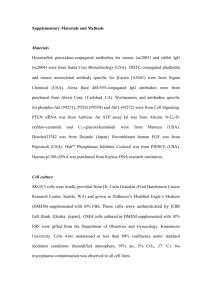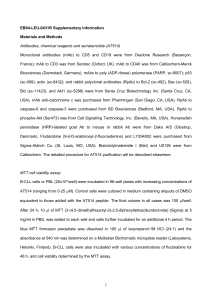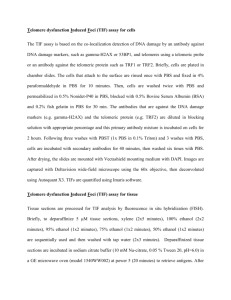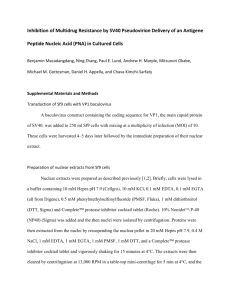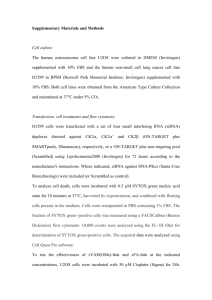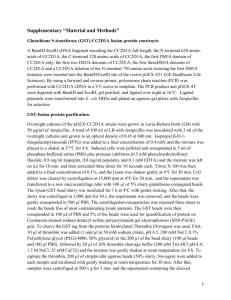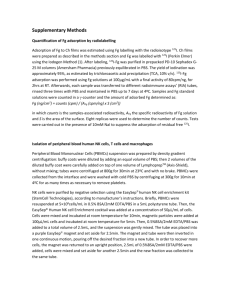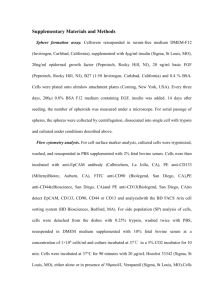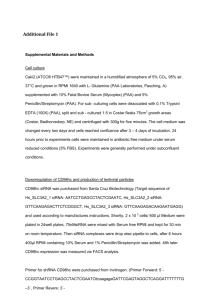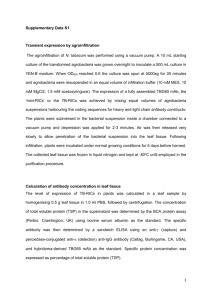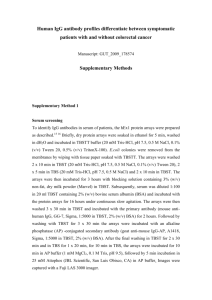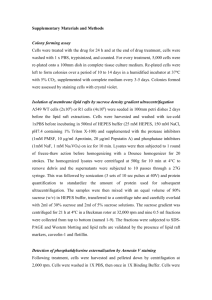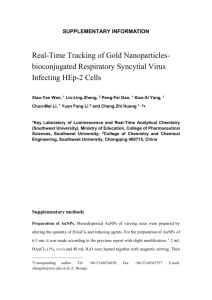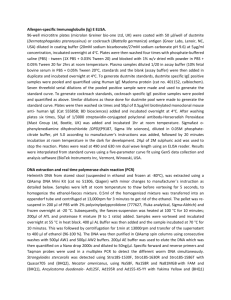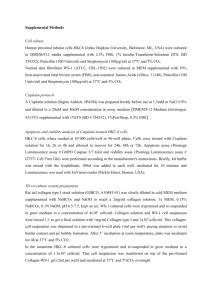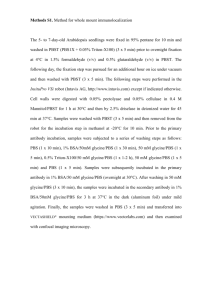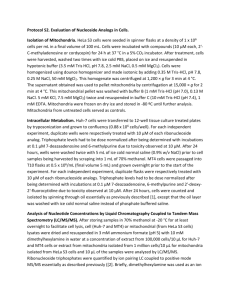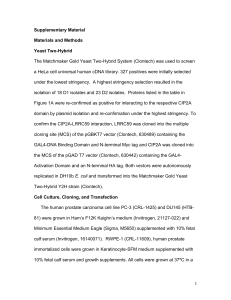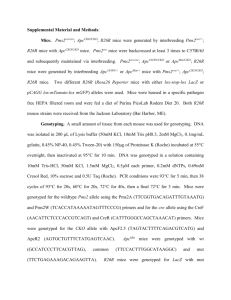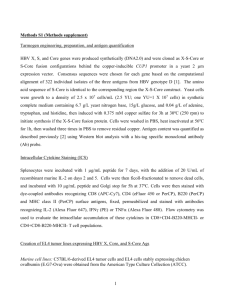SUPPLEMENTARY MATERIAL Inhibition of BRCT(BRCA1
advertisement
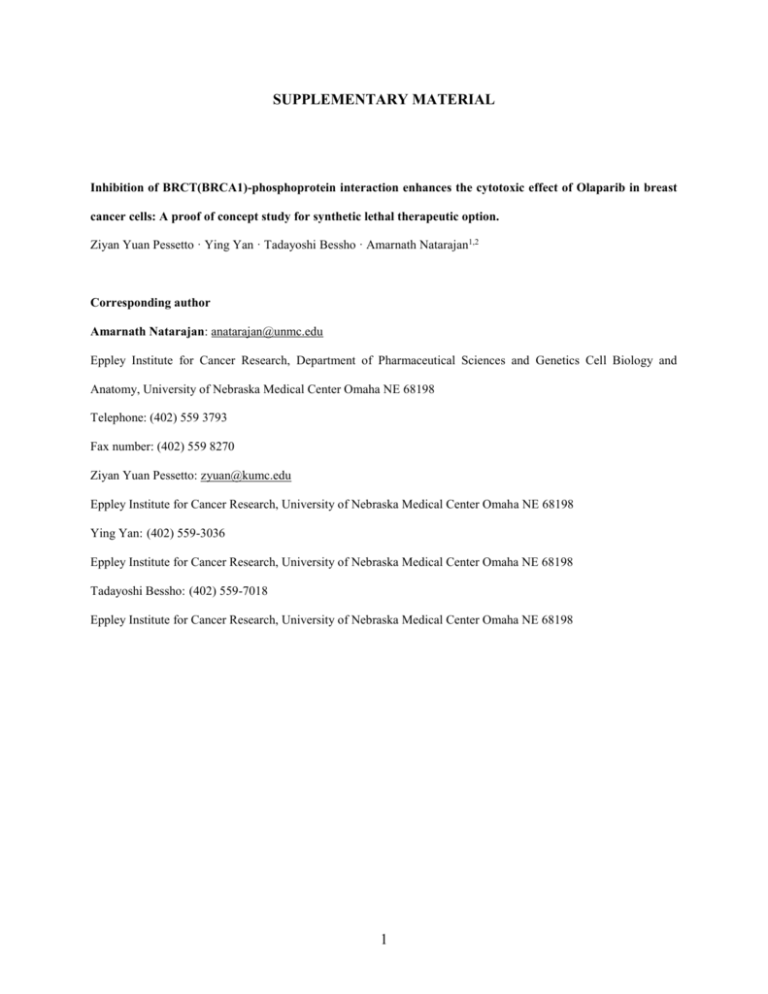
SUPPLEMENTARY MATERIAL Inhibition of BRCT(BRCA1)-phosphoprotein interaction enhances the cytotoxic effect of Olaparib in breast cancer cells: A proof of concept study for synthetic lethal therapeutic option. Ziyan Yuan Pessetto · Ying Yan · Tadayoshi Bessho · Amarnath Natarajan1,2 Corresponding author Amarnath Natarajan: anatarajan@unmc.edu Eppley Institute for Cancer Research, Department of Pharmaceutical Sciences and Genetics Cell Biology and Anatomy, University of Nebraska Medical Center Omaha NE 68198 Telephone: (402) 559 3793 Fax number: (402) 559 8270 Ziyan Yuan Pessetto: zyuan@kumc.edu Eppley Institute for Cancer Research, University of Nebraska Medical Center Omaha NE 68198 Ying Yan: (402) 559-3036 Eppley Institute for Cancer Research, University of Nebraska Medical Center Omaha NE 68198 Tadayoshi Bessho: (402) 559-7018 Eppley Institute for Cancer Research, University of Nebraska Medical Center Omaha NE 68198 1 Treatment of cells and preparation of cell lysates Cell lysates were prepared by scraping cells (150 cm 2, 80-90% confluent) into 500 µl of lysis buffer A (10 mM HEPES, pH 7.8, 10 mM KCl, 0.1 mM ethylenediamine tetraacetic acid (EDTA), 2 mM dithiothreitol (PMSF), 1×Halt protease inhibitor cocktail (Thermo scientific), and 1×Halt phosphatase inhibitor cocktail (Thermo scientific)). The cells were allowed to swell on ice (15 min), after which 32 µl 10% Nonidet P-40 (Sigma) were added, and the tube were vortexed vigorously and the homogenates were centrifuged. The nuclear pellet was resuspended in buffer B (20 mM HEPES, pH 7.8, 0.42 M NaCl, 5 mM EDTA, 5 mM dithiothreitol, 1 mM PMSF, 10% (v/v) glycerol, 1×Halt protease inhibitor cocktail, and 1×Halt phosphatase inhibitor cocktail) and the tubes were rocked gently at 4 ˚C. The supernatant were transferred to fresh tubes and protein contents were determined using the Bio-Rad protein assay (Bio-Rad Laboratories, Inc.) with various concentrations of bovine serum albumin as standards. Aliquots of the cell lysates were stored at - 80˚C. Western blotting and immunoprecipitation Equal amounts of protein were subjected to electrophoresis (Criterion TM precast gels, 4-15% tris-HCl, 1.0 mm, Bio-Rad Laboratories, Inc.) in a 1×Tris-Glycine-SDS running buffer (Bio-Rad Laboratories, Inc.) and transferred to poly (vinylidene difluoride) (PVDF) membranes (Immun-Blot TM PVDF membrane for protein blotting; Bio-Rad Laboratories, Inc.) for 12 h at 15V. Membranes were blocked in TBS containing 0.05% Tween 20 (TBST) and 5% nonfat milk for 2 h at room temperature. Appropriately diluted primary antibodies were incubated in TBS / 5% nonfat milk for 2 h at room temperature or overnight at 4 C. Membranes were washed in TBST three times for 15 min each. 2 Appropriately diluted secondary antibodies were incubated in TBS / 5% nonfat milk for 1 h at room temperature. Membranes were washed in TBST three times for 15 min. Proteins were detected by AmershamTM ECL plus western blotting detection system (GE healthcare). The following antibodies were used: anti-Abraxas (A302-181A, Bethyl); anti-BRCA1 (c-20) (SC-642, Santa Cruz); anti-BRCA1 (D-9) (sc-6954, Santa Cruz); anti-GAPDH (ab9484, abcam); anti-Lamin B1 (ab16048, abcam); secondary antibodies (goat anti-mouse and goat anti-rabbit) were purchased from SouthernBiotech. Primary antibodies were diluted 1:1000 and secondary antibodies at 1:10,000 dilutions. Modified RIPA lysis buffer (50 mM Tris-HCl pH 7.4, 1% NP-40, 0.25% sodium deoxycholate, 150 mM NaCl, 1 mM EDTA, 1 mM PMSF, 1×Halt protease inhibitor cocktail, and 1×Halt phosphatase inhibitor cocktail) was used to perform the immunoprecipitation. Equal amounts of protein lysates were precleared for 30 min with 30 µl of Pierce® Protein A/G Agarose (Thermo scientific) and fractions were incubated with appropriate primary antibody for 4 h at 4 ˚C. 30 µl of Pierce ® Protein A/G Agarose were then added and incubated overnight. The beads were washed three times with modified RIPA buffer and boiled in SDS-loading buffer. Western blotting assays were performed as described above. Immunofluorescence confocal imaging Hela cells (4000 cells per well) or HCC1937 cells (3000 cells per well) were seeded in 96-well optical plates (NUNC, New York) containing media (200 µl). After allowing the cells to adhere for 24 h, cells were treated with or without peptide 2 (10 µM). The cells were incubated for 1 h and subjected to different doses of IR (0, 5, 10, 15, and 20 Gy). After an additional 30 min incubation the cells were fixed by replacing 3 the growth medium with 100 µl of 100% ice-cold methanol for 10 min. The methanol was removed and the cells were washed 3 times with 200 µl PBS. PBS was removed and 100 µl BSA (5%) was added and incubated for 1 h at room temperature. BSA solution was removed and the cells were washed 3 times with 200 µl PBS. The cells were subjected to 50 µl of primary antibody (Anti-phospho-H2AX (S139), Active Motif) diluted 1:250 in BSA/PBS. The plates were then sealed, covered, and incubated overnight at 4 ˚C. The primary antibody was removed and the cells were washed 3 times with 200 µl PBS for 5 minutes each. The PBS was removed and 100 µl of secondary antibody (ChromeoTM 488 Goat anti-Rabbit IgG, Active Motif) (1:1000) was added to each well. Plates were incubated 1 h at room temperature. The secondary antibody was removed and cells were washed with 200 µl of PBS for 5 min each. Cells were analyzed on a Zeiss LSM 410 dual beam laser confocal scanning microscope. Images were captured at 10× or 63× by using objective lenses. Pictures were analyzed by using LSM image browser version 4.2.0.121 (Carl Zeiss Microimaging GmbH). 4

